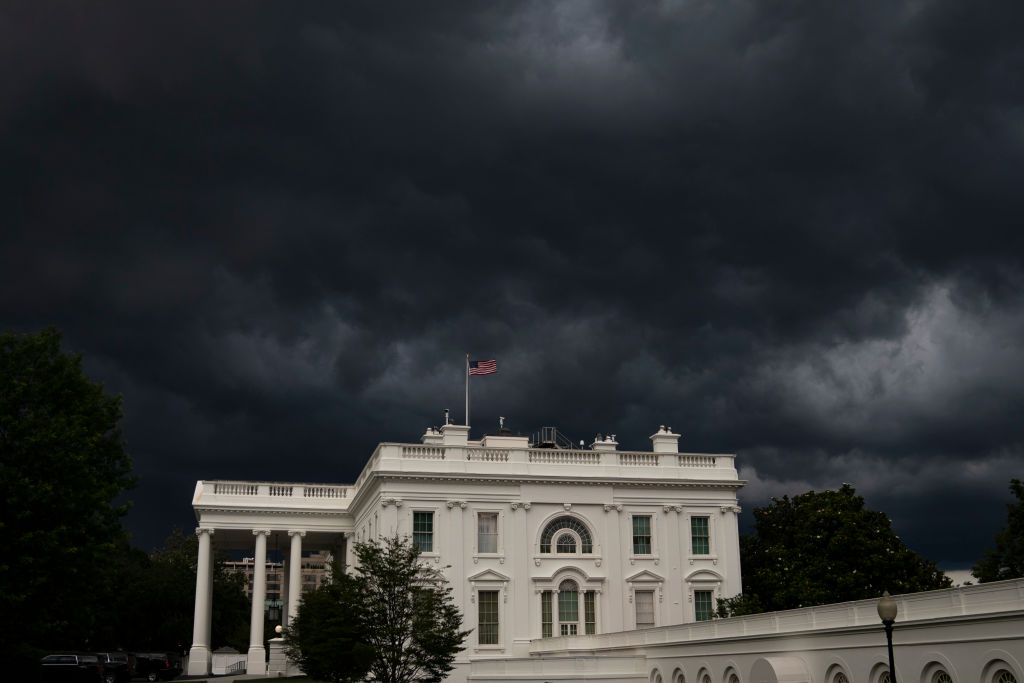Pandemic Nation
Gloom at the Top: Where Is America’s COVID Leadership?
As COVID-19 surges, service sector workers’ necks are again on the chopping block. Joe Biden’s new programs are 10 long weeks away.

The Trump administration’s long-running claim that, if not for COVID-19, its policies would have powered up the U.S. economy is pretty easily debunked. Even prior to the pandemic, Trump’s examples of his economic boom were mostly a mirage, as corporations that were handed massive tax breaks used the money primarily to buy back their own stock or distribute profits to wealthy shareholders and executives. Overall, the economy in 2019 was weaker than 2017 or 2018, Trump’s first two years in office.
Co-published by Patch
What is undeniably true is that the novel coronavirus in 2020 put things into a freefall that has yet to brake. Now, researchers indicate that the current massive spike in autumn COVID cases will wipe out the economic comeback of late summer. Trump’s mishandling of the health crisis is substantially to blame.
The country is bracing for its coldest weather and a wicked resurgence of COVID, with all the hurt that accompanies it — and virtually no transitional guidance from the Trump administration.
These realities all will follow President-elect Joe Biden into office in January: COVID remains a menace in the U.S.; its alarming surge almost assuredly will put certain sectors of the economy back into severe contraction; and low income wage earners are going to bear the brunt of the damage, just as they have throughout the past 10 months. Just recently, as the presidential election was being decided, the U.S. topped 100,000 new cases on four consecutive days, a grim new record.
Last week’s October jobs report helped spell out the issue. While unemployment fell to 6.9% from 7.9% in September, job growth slowed, with nonfarm payrolls showing their smallest gain since the recovery began in May. It was the fourth straight month of slower growth. And almost concurrent with that news came worries that the COVID spike will hit hard – especially if it severely curtails shopping, dining out and travel during the traditional holiday season.
What does it mean? Well, service sector workers’ necks are once again on the chopping block. As many as 1.4 million jobs in the retail trade, leisure and hospitality industries that have been recovered since April could be lost “if no further steps are taken to prevent a rise in positive COVID cases or to aid businesses in adapting service to the drop in temperatures,” according to a forecast by the payroll processing company Gusto.
“[Consumers] may pull back in a situation where suddenly the cases are everywhere,” Federal Reserve Chairman Jerome Powell said in a virtual press conference after the U.S central bank decided to keep short-term interest rates near zero. “That’s a risk that we have as we go into the fall now and the cases spike. That could weigh on economic activity. One would expect that it would.”
Low income earners will face a double whammy if this happens, as the original outbreak in February and March made clear. Not only do many of them lose their jobs when service sectors contract, but those who do continue working – in “essential” roles, as in food processing plants or agriculture – do so while being constantly exposed to the virus through their contact with fellow workers, often in crowded conditions and amid lax safety regulations.
Poorer Americans also tend to live in more crowded housing conditions, which can further the spread of virus. And they have higher rates of pre-existing medical conditions that leave them more vulnerable to COVID’s ravages. According to the COVID Racial Data Tracker, Blacks are dying from the virus at 2.2 times the rate of whites, with Latinos or Hispanics dying at 1.4 the rate of whites.
The help provided by the government’s initial $2.2 trillion stimulus package is long gone, and the Republican-controlled Senate has consistently failed to produce another relief effort. Meanwhile, at least 6.2 million people lost their employer-sponsored health insurance via the pandemic, according to the Economic Policy Institute, and millions more did not have company health plans to begin with.
The Biden administration that is being assembled is already signaling a change in its approach to COVID-19. In his victory speech on Saturday, Biden said his coronavirus task force will formulate a plan “built on a bedrock of science. It will be constructed out of compassion, empathy and concern. I will spare no effort – or commitment – to turn this pandemic around.”
Biden, though, won’t be sworn in for another 10 weeks. In the meantime, the country is bracing for its coldest weather and a wicked resurgence of COVID, with all the hurt that accompanies it, and virtually no transitional guidance from a Trump administration that never wanted the severity of the virus known in the first place. May the time pass quickly.
Copyright 2020 Capital & Main

-

 Locked OutDecember 23, 2025
Locked OutDecember 23, 2025Section 8 Housing Assistance in Jeopardy From Proposed Cuts and Restrictions
-

 The SlickDecember 19, 2025
The SlickDecember 19, 2025‘The Poor Are in a Very Bad State’: Climate Change Accelerates California’s Cost-of-Living Crisis
-

 Latest NewsDecember 22, 2025
Latest NewsDecember 22, 2025Trump’s War on ICE-Fearing Catholics
-

 Column - State of InequalityDecember 24, 2025
Column - State of InequalityDecember 24, 2025Where Will Gov. Newsom’s Evolution on Health Care Leave Californians?
-

 Latest NewsDecember 29, 2025
Latest NewsDecember 29, 2025Editor’s Picks: Capital & Main’s Standout Stories of 2025
-

 Latest NewsJanuary 8, 2026
Latest NewsJanuary 8, 2026Why No Charges? Friends, Family of Man Killed by Off-Duty ICE Officer Ask After New Year’s Eve Shooting.
-

 Latest NewsDecember 30, 2025
Latest NewsDecember 30, 2025From Fire to ICE: The Year in Video
-

 Column - State of InequalityJanuary 1, 2026
Column - State of InequalityJanuary 1, 2026Still the Golden State?

